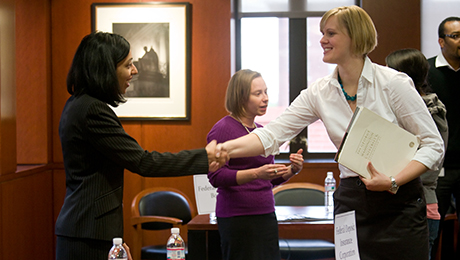Before finishing law school, Carissa Tyler, J.D. ’12, had helped refugees at the International Rescue Committee in Seattle, worked with detained immigrants at the Capital Area Immigrants’ Rights Coalition in D.C., and volunteered as a legal intern at the Department of Justice’s office of immigration litigation. With her extensive experience in immigration and human rights, she knew that she wanted to start practicing law as soon as she passed the bar.
However, young legal professionals today face challenges entering the job market nationwide. In response, the George Washington University Law School established the Pathways to Practice Program. The program places recent Law School graduates in fellowships with a range of legal employers, including small law firms, government offices, judges’ chambers and public interest organizations.
Ms. Tyler applied for the program and just months later, she secured a fellowship at Barst Mukamal & Kleiner in New York. She is now an associate at the boutique law firm, which specializes in worldwide immigration law—a perfect match for Ms. Tyler’s career aspirations.
“It gave me a chance to really build on my skills in an office setting and get my feet wet. I was able to start meeting with clients right away and start taking on different responsibilities immediately,” she said.
Despite difficulties in the legal economy, the GW Law School was among one of the top 10 schools placing the greatest number of graduates into large law firms. The National Law Journal recently reported the school had the second highest placement rate with public sector employers, and nearly 50 graduates received judicial clerkships last year.
The Pathways to Practice Program provides fellows with a stipend to work with a legal sponsor for a period of 12 months. This year, fellows took positions at the Robert F. Kennedy Center for Justice and Human Rights, the National Endowment for the Arts and the Senate Judiciary Committee. The program is new, and it is unclear if it will continue into future years, but the Law School explained they are committed to helping graduates succeed in the challenging job market.
Abraham Pollack, associate dean for professional development and career strategy at the Law School, said that the program has shown significant results since starting in 2011. The first year, 92 percent of participants found employment outside of the program within six months of completing their fellowship. At least 53 percent of these graduates gained positions within their fellowship or with similar employers.
“GW Law created the Pathways to Practice Program to help recent graduates obtain real-world legal experience. The professional experience our fellows gain helps them secure permanent employment, build their professional networks and obtain legal experience,” Mr. Pollack said.
Executive Director of the National Association for Law Placement James Leipold added that in the aftermath of the recession, many law schools implemented similar bridge programs to allow students to gain practical experience. These programs are popular at universities across the country, he said, because legal education systems do not have official apprenticeship years. He added that GW has been effective at measuring the success of its own program.
“We found that many schools did not do a very good job of tracking whether or not graduates obtained subsequent employment following their fellowships. It is impressive that GW is following its fellowship recipients so closely. The only way to know if the bridge to practice fellowships are effective is to scrupulously measure the outcomes in terms of subsequent employment,” Mr. Leipold said.
Dennis Corkery, J.D. ’12, joined the Washington Lawyers’ Committee as a fellow through the Pathways to Practice Program. He explained that the program led to his current position as a staff attorney on the committee’s equal employment opportunity project.
“The job I have is because of P2P—I was hired on directly at the conclusion of my fellowship,” he said. “I was able to work as an attorney when my job did not have the funding for me, all the while proving my worth so that they could make the funding happen.”
Ms. Tyler said that she has spoken with colleagues from other law schools who attended shorter bridge programs that didn’t boast the benefits of GW’s. The Pathways to Practice Program allowed her flexibility while acquainting her with a potential employer.
“P2P allowed me to gain a full-time position because it provided the firm with a chance to get a sense of my skills and abilities while I worked here as a fellow,” she said. “I was able to get to the job I wanted and the experience I had been working toward.”


